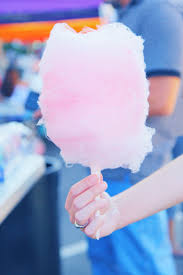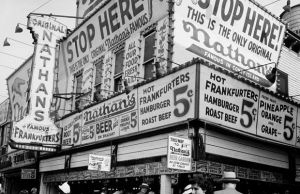
Concession Stands: Best Practices for Your Quick Serve Restaurant
Posted in:
Firing Up the Grill
It’s no secret that sports fans are passionate about their teams — and their game day food. With more than 20 billion hot dogs and 600 million pounds of peanuts consumed in the U.S. alone, the demand for ballpark food is substantial. In essence, the classic food options available at sporting events will always be bestsellers because they’re popular, delicious, and affordable.
That being said, it is important to recognize customer trends and realize that the “staple” sports arena fare isn’t always going to cut it – consumers now demand alternative choices while attending their favorite games including food options that are higher quality, healthier,

and more diverse in nature.
Consumers are becoming more and more educated on the intricacies of their food – preparation, sourcing, and ingredient information for all of your offering is all imperative. However, more than anything, customers are looking for an experience. People are looking for food that is going to complement their sports experience and make their time at the ballpark, ice rink, or court memorable.
The shift in consumer expectations to craving a more “experience-based” culinary experience has a lot of effects on different parties, especially food vendors and quick-service restaurants. What does this mean for your quick serve restaurant? There is an incredible opportunity to serve a passionate market of sports enthusiasts through concession stands. Let’s examine the history and role of concessions in sporting events and best practices for the restaurant brands looking to get involved.
The Halftime Rush
Concession stands and ballparks go hand in hand and the history of the two is quite blurry. Some historians date concession stands back to around 1882 with Chris Von de Ahe, the owner of the St. Louis Brown Stockings, now know as the St. Louis Cardinals. Von de Ahe noticed people frequented the saloon after baseball games and decided selling beer and hot dogs to a target audience at the games would be profitable. Other historians attribute concessions as we know it today to Harry M. Stevens, a man from Derby, England that was the founder of Harry M. Stevens Inc., the 1887 concessions company that would later be acquired by Aramark.
 Regardless of the inventor of the concept, concession stands play an integral role in today’s sporting event experience. From youth sports to amateur to professional sports stadiums, restaurants, chains and retailers can benefit immensely from becoming an official concessions stand provider.
Regardless of the inventor of the concept, concession stands play an integral role in today’s sporting event experience. From youth sports to amateur to professional sports stadiums, restaurants, chains and retailers can benefit immensely from becoming an official concessions stand provider.
Over the 100+ years that concessions have existed in sports venues, talented professionals and quick service industry pioneers have worked to develop best practices and make the dining experience the best it can be for spectators. Each year, new concepts emerge and trends are analyzed for topics like reducing wait time, food waste management and fluctuating rise and fall of food costs. In light of current trends, the following three best practices have developed to help guide both new and current concession stand owners toward success with their target audience:
1. Draft Your Best Players – As a QSR, it is essential to have people in the concession stand that are truly passionate not only about your product and but also making the customer experience the best it can be. Though interactions should be quick, customers will remember both a poor interaction or a friendly face. Consumers of this era demand experiences, and your most passionate employees will go far in creating memorable experiences for consumers.

Take for example Zappos, a successful online retail giant, that invests in an extensive training program for every employee. The program allows new trainees the proper amount of time to get accustomed to the Zappos’ brand voice. By training their employees in all things Zappos, the company creates an environment in which employees are empowered to live out values like “embrace and drive change.” Other retailers can take a page out of the Zappos playbook, and encourage driven employees to take ownership over the concession stand, which will create the best experience for your customers.
2. Location, Location, Location – Understanding your consumer and the role that your QSR plays in their experience is essential. Try to position your stand in a place that is convenient for their sports experience. Are your customers the type of fans that sit closer to the field? Those that only get up during half time? These nuances are critical for getting the most out of your concessions success.
Don’t be afraid to incentivize potential consumers with offers that will get more traffic to your stand. For example, Quakertown Youth Baseball, a youth baseball organization in Pennsylvania, has created concession stand gift cards that parents can preload money onto and give to their players. By understanding their demographic and the stand location, they are able to address the parent’s concerns and the player’s needs. It is increasingly important to have a detailed understanding of your consumers wants, needs, and expectations to format the location of the stand and its inner workings. Additionally, assess the surrounding food options in proximity to your stand. If the stadium allows other similar brands, you may have to get creative to fight for market share by reducing your prices and offering special discounted promotions to loyal fans.
3. Simplify – It’s important to recognize that while you are creating a unique food experience, most fans are still engaged in the game. Most likely, your concession stand will have limited space and resources. Therefore, it is important to utilize the space you have by creating processes to make each transaction efficient. Consider prepping all the food at another location and transporting it directly to the venue. Additionally, make the buying process as seamless as possible for your target audience – having a self-serve drink station at your concessions area and serving your five-best selling food items have proven to be effective strategies. Chris Burr, director of nontraditional development at Dunkin’ brands said it best: “When operating in a nontraditional venue, it’s essential that you don’t leave any details to chance and make sure that you can execute your food and service at a very high level with products that represent your brand.” It is proven time and time again, simplicity is key.
Wrap it Up
Concession stands are an integral component of the sports experience — whether it be at a professional game or a hometown match, food and spectators go together. The opportunity to market your QSR to a passionate demographic could be the perfect next step for your organization. By following the practices of hiring and training your best employees, thoroughly considering your location and target demographic and simplifying your restaurant practices, you will be best equipped to delight your customers.
